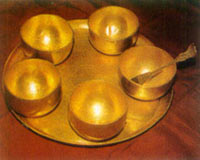The Panchapatre
The priest then divides the water
for various purposes. He arraoges five large vessels known
as Panchapatre in a large circular plate in order to conduct
Arghya, Pay'a, Achamaniya, Snaniya and Sarvarta
and apportions the water, mixed with different ingredients
for different purposes, into each vessel. The water for
washing the feet is placed in the south-west corner of
the plate. Water for sipping is placed in the north-west
corner. Water for oblation occupies the south-east corner
of the plate.
In the centre is kept the vessel
containing water for general purposes and a few Tulsi
leaves; some flowers, gingelley
seed and sandal paste are added to it.
 |
Five
gold panchapatre,an uddharane on a gold
plate |
|
There are, however, varying
prescriptions in the agamaic texts regarding
the number of vessels placed in front of the deity.
Gold is considered best for
making the panchapatre. Silver is of medium
merit and copper comes next. By and large, gold
and silver vessels are donations from benevolent
(u1ers.ltwas customary for the donors to offer five
vessels either in silver or gold.
|
